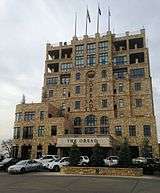Mount Oread
Mount Oread /ˈɔːri.æd/ is a hill in Lawrence, Kansas upon which the University of Kansas is located.[1] It sits on the water divide between the Kansas and Wakarusa rivers. It was named after the Oread Institute in Worcester, Massachusetts. The hill was originally called Hogback Ridge by many Lawrence residents until the Oread name was adopted in 1866.[2]
| Mount Oread | |
|---|---|
_(cropped).jpg) Old North College, the first building on the University of Kansas campus, at the northeast promontory of Mount Oread, looking north over Lawrence and the Kansas River, ca. 1867 | |
| Highest point | |
| Elevation | 1,037 ft (316 m) |
| Coordinates | 38°57′47.32″N 95°15′25.51″W |
| Geography | |
 Mount Oread | |
| Geology | |
| Age of rock | Carboniferous |
For emigrants going westward by wagon train on the Oregon Trail, "The Hill", as Mount Oread is now commonly referred to by residents of Lawrence, was the next big topographical challenge after crossing the Wakarusa River near today's Haskell Indian Nations University.

According to the United States Geological Survey, Mount Oread is located approximately 1,037 feet (316 m) above sea level. By way of comparison, downtown Lawrence is about 846 feet (258 m) above sea level. Mount Oread is perhaps best known for being the staging area of William Quantrill's raid into Lawrence on August 21, 1863, during the American Civil War. Presently, the campus of the University of Kansas (KU) rests on Mount Oread.
Mount Oread is the type locality for the Oread Limestone, and so, gives its name to the Oread Escarpment rising in this region of Kansas. Oread Limestone was quarried from the hilltop and used in the earliest of the campus buildings of KU, including Spooner Hall and Dyche Hall.[3]
See also
References
- Blackmar, Frank Wilson (1912). Kansas: A Cyclopedia of State History, Volume 2. Standard Publishing Company. pp. 331.
- "This Week in KU History". Archived from the original on 2012-11-30.
- National Register of Historic Places Registration Form: University of Kansas Historic District (PDF), National Park Service,
Local craftsmen quarried Oread limestone from the north slope of the ridge for the first generation of buildings.
External links
- Lawrence Kansas looking northeast from Mt. Oread (1859)
- Mt. Oread campus buildings at the University of Kansas.
- TopoQuest map of Mt. Oread
- Mount Oread trail route marker for KU GIS Day 2006 social geocoding pioneers